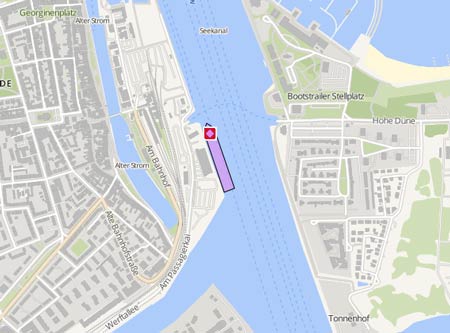ALTON ST AMANT
Course/Position
Latest ports
Latest Waypoints
Latest news
NTSB report into flooding published
The National Transportation Safety Board (NTSB) has released details of its investigation into the May 17, 2020, flooding of the 'Alton St. Amant'. She had arrived on April 1, 2020, to Bollinger Quick Repair, a shipyard on the Harvey Canal across the Mississippi River from New Orleans. The vessel was there to be drydocked and receive major maintenance work. The NTSB noted in its marine accident brief that no crew members were aboard the vessel during the maintenance work, though a Blessey port engineer was assigned to oversee the project. The 'Alton St. Amant' was moved on May 9, 2020, from the drydock to a wet berth at Bollinger Quick Repair for completion of its scheduled maintenance work. THe NTSB noted that the following work remained to be done: “two bilge pumps, which had been removed from the vessel for overhaul, were to be reinstalled; the sealing rings of several of the vessel’s tank access hatches were to be replaced; and the sealing surfaces of the hatches were to be cleaned.” The vessel was scheduled for sea trials on May 18, 2020. On May 15, 24,000 gallons of fuel were loaded onto the Alton St. Amant. “The flush hatches to the vessel’s two potable water tanks located on the main deck in the rudder room had been opened for maintenance, but the covers were not reinstalled at the end of the day.” On the same day, the Blessey port engineer had asked the shipyard to fill the vessel’s two potable water tanks. The following day, a shipyard pipefitter and three other workers returned to the vessel to reinstall bilge pumps. With that completed by about 10 a.m., the pipefitter began filling the potable water tanks “from a shoreside water manifold that was connected to the vessel’s potable water fill pipe via a 2-inch hose through the open exterior engineroom doors." The combined capacity of the two potable water tanks was 13,233 gallons. “Unaware that the potable water tank access hatches were open in the rudder room, he left the shipyard about 10:30 with plans to return the next day. He intended to fill the tanks and then allow them to overflow onto the exterior main deck through their vents to flush out any residual debris inside before turning off the water supply.” For the rest of that day and overnight, water continued to flow into the two potable water tanks, and the 'Alton St. Amant' remained unmonitored. About 6:30 a.m. on May 17, 2020, a shipyard worker noticed the 'Alton St. Amant' was sitting low in the water and alerted the shipyard’s general manager. After finding the vessel’s engineroom flooded and its main deck partially submerged, the shipyard general manager notified the U.S. Coast Guard, Blessey Marine officials and a salvage company. The general manager, at that time, noticed the water hose was still connected to the vessel and charged. He then shut off the water line. By 4:30 p.m. a crane lifted the 'Alton St. Amant' from the water and refloated the vessel. By that night, the vessel was returned to the drydock and inspected, with no leaks or seepages found. “The following morning, shipyard workers who were disconnecting electrical power cables from the recovered vessel found the potable water hose still connected to the fill pipe on the Alton St. Amant. They also discovered that the access hatches for the potable water tanks in the rudder room were open.” According to the NTSB, the pipefitter later told investigators that he did not know the access hatches were open. While pre-work safety meetings took place daily, “the status of these hatches was not communicated to the pipefitter,” the report said. After the incident, Bollinger Quick Repair put new procedures in place for conducting water transfers, which include “pre-inspection of tanks, valves, piping and other components of the vessel’s water system,” according to the NTSB. In addition, “water transfers were to be monitored for the duration of the filling process,” the report stated. With no one on board, the potable water tanks aboard the 'Alton St. Amant' reached their capacity and began overflowing through the open hatches in the rudder room. From there, water flowed onto the main deck and down into the engine compartment. “With the bilge system inoperable due to planned maintenance during the shipyard period and no one aboard the vessel to monitor the water transfer, the potable water continued to fill the aft spaces undetected and submerged the vessel until it came to rest on the bottom of the canal,” the NTSB concluded. The NTSB estimated the damage aboard the 'Alton St. Amant' to be $1.5 million.
Upload News

